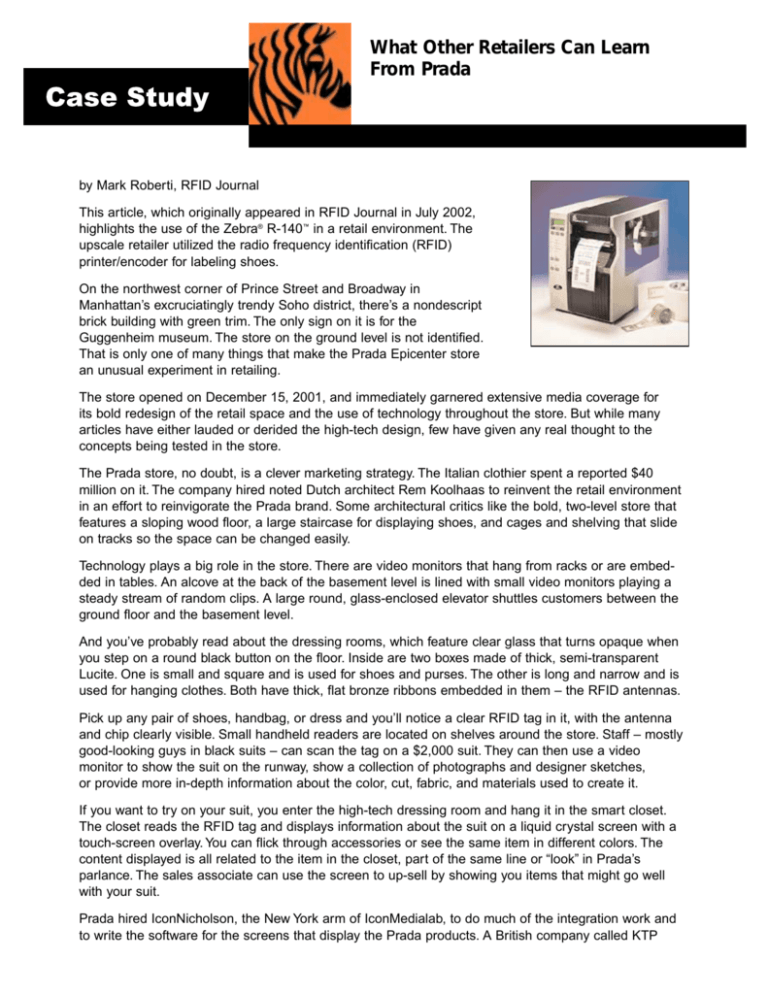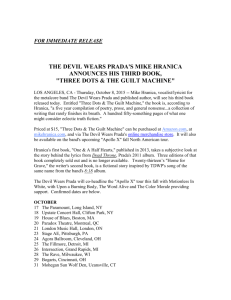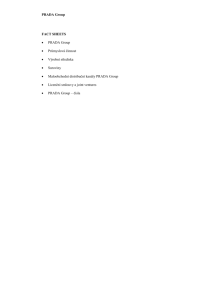
What Other Retailers Can Learn
From Prada
by Mark Roberti, RFID Journal
This article, which originally appeared in RFID Journal in July 2002,
highlights the use of the Zebra® R-140™ in a retail environment. The
upscale retailer utilized the radio frequency identification (RFID)
printer/encoder for labeling shoes.
On the northwest corner of Prince Street and Broadway in
Manhattan’s excruciatingly trendy Soho district, there’s a nondescript
brick building with green trim. The only sign on it is for the
Guggenheim museum. The store on the ground level is not identified.
That is only one of many things that make the Prada Epicenter store
an unusual experiment in retailing.
The store opened on December 15, 2001, and immediately garnered extensive media coverage for
its bold redesign of the retail space and the use of technology throughout the store. But while many
articles have either lauded or derided the high-tech design, few have given any real thought to the
concepts being tested in the store.
The Prada store, no doubt, is a clever marketing strategy. The Italian clothier spent a reported $40
million on it. The company hired noted Dutch architect Rem Koolhaas to reinvent the retail environment
in an effort to reinvigorate the Prada brand. Some architectural critics like the bold, two-level store that
features a sloping wood floor, a large staircase for displaying shoes, and cages and shelving that slide
on tracks so the space can be changed easily.
Technology plays a big role in the store. There are video monitors that hang from racks or are embedded in tables. An alcove at the back of the basement level is lined with small video monitors playing a
steady stream of random clips. A large round, glass-enclosed elevator shuttles customers between the
ground floor and the basement level.
And you’ve probably read about the dressing rooms, which feature clear glass that turns opaque when
you step on a round black button on the floor. Inside are two boxes made of thick, semi-transparent
Lucite. One is small and square and is used for shoes and purses. The other is long and narrow and is
used for hanging clothes. Both have thick, flat bronze ribbons embedded in them – the RFID antennas.
Pick up any pair of shoes, handbag, or dress and you’ll notice a clear RFID tag in it, with the antenna
and chip clearly visible. Small handheld readers are located on shelves around the store. Staff – mostly
good-looking guys in black suits – can scan the tag on a $2,000 suit. They can then use a video
monitor to show the suit on the runway, show a collection of photographs and designer sketches,
or provide more in-depth information about the color, cut, fabric, and materials used to create it.
If you want to try on your suit, you enter the high-tech dressing room and hang it in the smart closet.
The closet reads the RFID tag and displays information about the suit on a liquid crystal screen with a
touch-screen overlay. You can flick through accessories or see the same item in different colors. The
content displayed is all related to the item in the closet, part of the same line or “look” in Prada’s
parlance. The sales associate can use the screen to up-sell by showing you items that might go well
with your suit.
Prada hired IconNicholson, the New York arm of IconMedialab, to do much of the integration work and
to write the software for the screens that display the Prada products. A British company called KTP
handled the RFID technology. Texas Instruments’ RFID tags and Zebra Technologies’ printer/encoders
were specified.
Bruce Eckfeldt, Icon’s engagement manager on the project, describes the Epicenter store as a cross
between a concept store and a laboratory.
“Prada wanted to test some concepts in the real world,” he says. “They will see what works and then
deploy it in other stores as is or in some modified way. It gives them the opportunity to learn based on
feedback and to build a better and more successful retailing environment in the future.”
So what’s working? Unfortunately, its still too early to tell. And Prada declined to be interviewed for this
article. But even without hard numbers, it’s clear that the Prada store is pioneering some retailing
concepts that will likely become common in the years ahead.
Smart Retailing Concepts
The splashy technology and expensive architecture at the Prada store have, at least in the media, overshadowed some creative retailing concepts. The store is about the customer experience. That’s a cliché
these days, but what Prada is trying to do is provide -- in part through the use of technology -- a level of
service that has never been possible before.
Let’s say you shop at Prada regularly. The store presents you with a convenience card (Prada calls it a
customer card). You can shop anonymously, or you can present your card to a sales associate, who
scans the RFID chip in it. You are identified, and your preferences are immediately called up. If you have
a favorite sales associate, he or she can be alerted that you have arrived. If not, any sales
associate in the store can quickly review your personal preferences. If you have purchased several pairs
of dress shoes recently, the associate might ask if you would like to see a few new designs that have
just come in.
The idea is to give a level of service that is superior to anything except the by-appointment-service of
upscale boutiques. (Prada offers that, too, of course. If you’re Cher or Bono you can make an appointment, go in a separate back entrance and have clothes brought to you in a comfortable lounge.)
So let’s say you have a favorite salesperson named George. You tell him you are looking for a new suit
for a dinner party tonight. He shows you one in navy that you like. You try it on in the dressing room, but
when you dim the lights in the room, you feel it’s a tad too dark. George can show you different shades
of the same suit on the screen in the dressing room. If you are back on the floor, George can use his
handheld reader to scan the RFID tag on the suit, call it up on a video screen hanging on the rack or
embedded in a table, and show you three other shades.
Every item that enters the store is tagged (later the tags may be put on at the source). The sales
tools are tied to a real-time inventory system on the back end, so George shows you only colors and
sizes that are in stock. In the future, George will also be able to tell you what’s available in other New
York stores, the local warehouse, or even what you can see if you drop in to the Prada store in Paris
next week.
Prada considered extending the current real-time inventory capabilities of the handheld wireless device
by linking the sales floor with the storeroom. The company never implemented it, but the idea is a good
one. Here’s how it could have worked: You want to see that suit in a summery beige. Once George
has confirmed that the suit is in stock using his handheld computer, he could then signal Rita in the
backroom to place it in the dressing room. George never has to leave your side. The handheld readers
could also be linked wirelessly to the point-of-sale terminal, so when you want to pay, the transaction
can be completed on the floor.
“There’s a lot of technology in the store, but we didn’t want it to be obtrusive,” says Icon’s Eckfeldt. “It’s
about facilitating the customer’s relationship with the salesperson. That’s the primary tenet of the store.”
Given the prices Prada charges, it can afford to provide this level of service. But the concepts here can
apply to all retailers. Companies like the Gap have run RFID tests and learned that they can increase
sales simply by having sales staff on the floor spending more time with the customer and less time
with the stock. Even a discount shoe store could set up a kiosk where customers get information about
pricing, available colors, and sizes, then push a button to request that an item be brought out from the
back room.
Merging Online and Offline Channels
Another concept Prada is experimenting with is merging the online and offline channel. Once George
has helped you pick out a few items you want to try on, they are brought to the dressing room and
placed in a smart closet. Prada plans to offer a system where the sales associate creates a session for
you and everything you hang in the closet is identified. If you want, you can save the information in your
personal database. The idea is the next day, when you have time at work, you can go online to a
special Web site created for top customers and see the items in your “digital closet.”
You will be able to get more information about the items or see related products. You can’t actually
order anything and pay with your credit card, since Prada wants the relationship to be personal. But
there is a tool that lets you send a message to sales associates. You can tell them that you’d like to
come in and try on a few related items you found on the Web, or arrange to pick up the handbag you
picked out for your wife at the store. This lets Prada maintain the customer relationship even when
you aren’t in the store.
“There will be a series of tools that will be on the Web that will give customers access in different ways,
and these will change over time,” says Eckfeldt. “As Prada develops new ideas, there will be new things
that will let people experience the collection in new ways.”
Putting Ideas into Practice
The Prada store has been open six months, and it is perhaps unfair to draw too many conclusions. But
it’s worth pointing out some observations. First, if RFID is to be used as a sales tool, salespeople must
be trained in how to use the software that is supposed to add value and they must be comfortable with
it. I spent a couple of hours in the Prada store over the course of a few days, and I never saw one of the
staff pick up a handheld device. One salesperson I spoke to in late April didn’t even know he could scan
a tag and show information about the item on the video screen.
Prada says the staff is now trained to use the technology, but it may take some time for both customers
and staff to get used to it. Staff turnover is as common in retailing as returns, which means training has
to be continuous. Any retailer considering a system like Prada’s should factor that into their costs. It will
also be important to have very intuitive software.
The basic concept, however, of being able to scan an item and learn more about it is a good one. Some
customers might like staff to have that information at their fingertips and some may prefer to use kiosks
on their own.
This could be an incredible sales tool. Imagine smart technology that recommends an accessory based
on your personal history or based on what other customers who looked at similar items bought. If you
have purchased a lot of items with earth-tone colors recently, the system could automatically show you
new shirts and slacks in brown or olive. This isn’t easy to do successfully – just look at how many companies have failed in attempts to personalize the online shopping experience.
The ability of staff to know exactly what’s in stock is key. Prada didn’t say why they didn’t go ahead with
the wireless network, but the ability to communicate with someone in the backroom via wireless handheld device is an obvious improvement on current retailing technology. It will be at least a few years
before retailers can get accurate inventory information via RFID tags. By that time, wireless technology
may come down in price to the point where every store can use it in this way. The concept makes so
much sense it seems inevitable that this will become standard retailing procedure one day.
Prada’s attempt to integrate a personal Web site with the retail channel is an interesting concept, but it’s
difficult to say whether it will catch on. Clearly there will be a melding of online and offline channels, and
retailers will discover what works only by experimenting. RFID could have a role to play here because it
can link specific items to specific customers, making it possible to track not just what people bought,
but what they considered buying.
Interestingly, Prada doesn’t use RFID to make sure that the items are in the right place on the shelves
or racks. But it doesn’t have 90,000 SKUs like your typical Wal-Mart, so this isn’t a big problem. It also
doesn’t use RFID tags for security. Again, that’s not a big issue. RFID only helps thwart shoplifting when
it can signal someone has just swiped 20 Atra razors. It’s unlikely that anyone is going to scoop up 20
Prada handbags or pairs of shoes.
It’s hard to imagine a lot of retailers running out tomorrow to install systems like this. For one thing, the
tags Prada uses probably cost close to $1 with the inlay and adhesive backing to put them on items.
Second, the aim here is not to cut supply chain costs; it’s to improve service.
In two years, Prada may be up-selling enough customers using the system to get a return on its investment. But other retailers, particularly in the current economic environment, are going to wait until that
case is proven. But this is the direction in which retailing is going to move. Now is a good time to start
learning about the technology and the changes in business processes that it will bring.
Copyright © 2002 RFID Journal, Inc. All Rights Reserved.
HEADQUARTERS
Zebra Technologies International, LLC PHONE: +1 847.634.6700 or +1 800.423.0442 FAX: +1 847.913.8766
ADDRESS: 333 Corporate Woods Parkway, Vernon Hills, IL 60061-3109 U.S.A. WEB: www.zebra.com
OTHER LOCATIONS
USA: California, Florida, Rhode Island, Wisconsin EUROPE: Denmark, France, Germany, Italy, United
ASIA-PACIFIC: Australia, China, Japan, Singapore, South Korea LATIN AMERICA: Argentina, Brazil
MIDDLE EAST: United Arab Emirates
Kingdom
An ISO 9001 registered company
©2003 ZIH Corp.
Printed in U.S.A.
#13128L (02/03)












